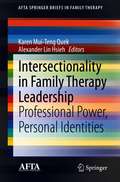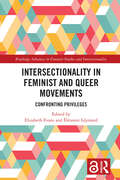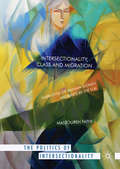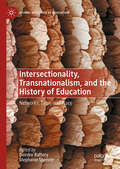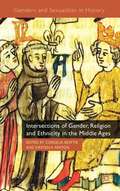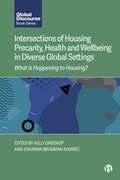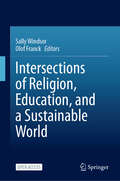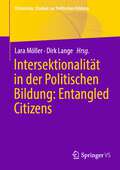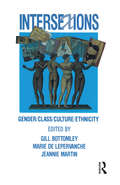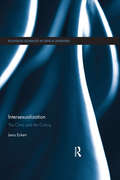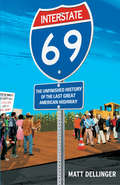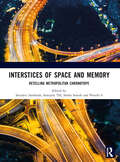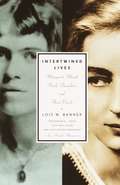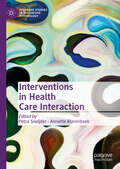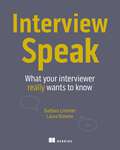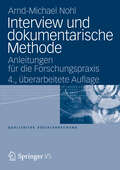- Table View
- List View
Intersectionality in Family Therapy Leadership: Professional Power, Personal Identities (AFTA SpringerBriefs in Family Therapy)
by Karen Mui-Teng Quek Alexander Lin HsiehThis brief examines the ways in which sociocultural characteristics and contexts intersect to create varying dimensions of social advantage and inequality that, in turn, affect and organize professional relationships in educational and therapeutic settings. It explores how inherently hierarchical relationships develop within educational and university contexts, including between professors and students, supervisors and supervisees, clinicians and clients, and administrators and faculty members. The volume addresses how participants’ social locations inform their roles and actions and how they can hold positions of power while also embodying a marginalized identities.In addition, the book draws on perspectives of persons marginalized or privileged based on their race/ethnicity, sexual orientation, and/or gender to examine how social location impacts their work as family therapy clinicians, supervisors, instructors, and administrators. Grounded in individual reflection and detailed experiences, each chapter describes rich personal narrative on how the individual therapist’s intersecting social locations influence his/her professional relationships. This book highlights the need for family therapists to identify their social location characteristics, evaluate the impact of their social location on their professional relationships, and process the role social location has on their academic, supervisory and clinical position. This volume is an essential resource for clinicians and practitioners, researchers and professors, and graduate students in family studies, clinical psychology, and public health as well as all interrelated disciplines.
Intersectionality in Feminist and Queer Movements: Confronting Privileges (Routledge Advances in Feminist Studies and Intersectionality)
by Elizabeth Evans Éléonore LépinardExamining the ways in which feminist and queer activists confront privilege through the use of intersectionality, this edited collection presents empirical case studies from around the world to consider how intersectionality has been taken up (or indeed contested) by activists in order to expose and resist privilege. The volume sets out three key ways in which intersectionality operates within feminist and queer movements: it is used as a collective identity, as a strategy for forming coalitions, and as a repertoire for inclusivity. The case studies presented in this book then evaluate the extent to which some, or all, of these types of intersectional activism are used to confront manifestations of privilege. Drawing upon a wide range of cases from across time and space, this volume explores the difficulties with which activists often grapple when it comes to translating the desire for intersectionality into a praxis which confronts privilege. Addressing inter-related and politically relevant questions concerning how we apply and theorise intersectionality in our studies of feminist and queer movements, this timely edited collection will be of interest to students and scholars from across the social sciences and humanities with an interest in gender and feminism, LGBT+ and queer studies, and social movement studies.
Intersectionality, Class and Migration: Narratives of Iranian Women Migrants in the U.K. (The Politics of Intersectionality)
by Mastoureh FathiThis book offers critical analysis of everyday narratives of Iranian middle class migrants who use their social class and careers to "fit in" with British society. Based on a series of interviews and participant observations with two cohorts of "privileged" Iranian migrant women working as doctors, dentists and academics in Britain--groups that are usually absent from studies around migration, marginality and intersectionality--the book applies narrative analysis and intersectionality to critically analyse social class in relation to gender, ethnicity, places and sense of belonging in Britain. As concepts such as "Nation," "Migrant," "Native," "Other," "Security," and "Border" have populated public and policy discourse, it is vital to explore migrants' experiences and perceptions of the society in which they live, to answer deceptively simple questions such as "What does class mean?" and "How is class translated in the lives of migrants?"
Intersectionality, Transnationalism, and the History of Education: Networks, Time, and Place (Global Histories of Education)
by Deirdre Raftery Stephanie SpencerThis volume brings together a diverse range of contributors to explore the significance of intersectionality and transnationalism, with reference to the history of education. The chapters cover a range of educational spaces and places and demonstrate the possibilities that theoretical approaches can offer to scholars at all levels of their academic career. The chapters focus specifically on women’s activism in order to maintain a coherent framework of research that is brought together in an introduction and concluding thoughts. The significance of gender as relational and a symbol of power ensures that men and masculinities are not overlooked but recognized as integral to understanding gender dynamics as they affected women’s education and the ways in which that education took place.
Intersections With Attachment
by William M. Kurtines Jacob L. GewirtzAttachment has long been a key area of social development. Work on attachment processes has involved a variety of species as well as humans in diverse cultures and at various points in the life cycle. This volume presents research devoted to the meaning and implications of the attachment concept, including possible indices of attachment, the role of learning, whether or not attachment is best treated as continuous or discontinuous, and considerations for viewing attachment as a trait across environmental settings or as a process with functions that operate differently in disparate settings. Other psychological-process concepts, such as imprinting, relationships, and identification are also discussed. Because the contributors are active researchers and theorists, this volume may help establish trends and determine directions to shape literature on attachment for years to come.
Intersections of Gender, Class, and Race in the Long Nineteenth Century and Beyond (Palgrave Studies In Nineteenth-century Writing And Culture )
by Barbara LeonardiThis book explores the intersections of gender with class and race in the construction of national and imperial ideologies and their fluid transformation from the Romantic to the Victorian period and beyond, exposing how these cultural constructions are deeply entangled with the family metaphor. For example, by examining the re-signification of the “angel in the house” and the deviant woman in the context of unstable or contingent masculinities and across discourses of class and nation, the volume contributes to a more nuanced understanding of British cultural constructions in the long nineteenth century. The central idea is to unearth the historical roots of the family metaphor in the construction of national and imperial ideologies, and to uncover the interests served by its specific discursive formation. The book explores both male and female stereotypes, enabling a more perceptive comparison, enriched with a nuanced reflection on the construction and social function of class.
Intersections of Gender, Religion and Ethnicity in the Middle Ages
by Cordelia Beattie Kirsten A. FentonThis collection of essays focuses attention on how medieval gender intersects with other categories of difference, particularly religion and ethnicity. It treats the period c. 800-1500, with a particular focus on the era of the Gregorian reform movement, the First Crusade, and its linked attacks on Jews at home.
Intersections of Housing Precarity, Health and Wellbeing in Diverse Global Settings: What Is Happening to Housing? (Global Discourse)
by Kelly Greenop and Johanna Brugman AlvarezThis book examines the specific manifestations and causes of housing precarity across a diverse range of geographic settings and housing types. Housing has been in crisis across the globe for decades. Precarious housing is defined as that which fails to provide an adequate standard of living to enable health and wellbeing for a person and their family. This book argues that, while causes are often structural, the forms of housing precarity need to be deeply and specifically understood in order to propose solutions. Bringing together contributions from diverse academics across different geographies in the global north and south, chapters offer fresh insights into how housing affects wellbeing in terms of physical and mental health, identity and participation in communities.
Intersections of Religion, Education, and a Sustainable World
by Olof Franck Sally WindsorThis open access volume contains up-to-date, informed perspectives on how sustainable development issues can be integrated into religious education. With a focus on issues that frequently appear in policy documents related to Education for Sustainable Development, this volume offers valuable guidance and research on how teacher education, didactics and pedagogy can be developed to better integrate these issues in religious education. The chapters include contributions from all over the world, thereby highlighting the importance of integrating the issue of environmental sustainability and sustainable development in all forms of religious education. This text appeals to educators, researchers and policy makers interested in the intersection of sustainability and religious education.
Intersections: Interdisciplinary Research on Architecture, Design, City and Territory (Springer Geography)
by Emanuele Giorgi Magdalena VicuñaThis book presents a critical vision of the role of architecture and design in constantly changing cities, territories and societies from a Latin American perspective. Topics include, pandemic and post-pandemic; public culture and aesthetics; right to housing, city and services, gender approach and ethics of care; heritage and cultures, critical methodology; sustainable landscapes; perceptions and emotions; processes and technologies; territories and intermediate cities. The IV Intersections Congress was organized by high-level universities in Latin American: faculties of architecture, design and urban studies that came together during an historical moment of great changes. The congress was an invitation to weave conversations that address the tensions emerging in local, regional and global debates, with the goal of understanding how architecture, design, city and territory are a relevant intersection for these tensions. This translation was done with the help of artificial intelligence. A subsequent human revision was done primarily in terms of content.
Intersektionalität in der Politischen Bildung: Entangled Citizens (Citizenship. Studien zur Politischen Bildung)
by Dirk Lange Lara MöllerDieser Sammelband widmet sich dem Schwerpunktthema Intersektionalität und den damit verbundenen Impulsen, Anregungen und Schlussfolgerungen für die Politische Bildung. Der Begriff der Intersektionalität erlaubt es dabei, eine subjektbezogene und lebensnahe Perspektive zu berücksichtigen. Die Beiträge des Sammelbandes diskutieren, wie in einer subjektbezogenen Politischen Bildungsarbeit existierende Interdependenzen und Überschneidungen verschiedener Diskriminierungsformen in der Gesellschaft erfasst werden können. Der Band will dazu beitragen, die didaktischen Potenziale unterschiedlicher Forschungshintergründe vorzustellen und damit verbunden theoretische Überlegungen und empirische Erkenntnisse zum Thema Intersektionalität in der Politischen Bildung zu präsentieren.
Intersex, Variations of Sex Characteristics, DSD: Critical Approaches (Routledge Advances in Critical Diversities)
by Surya Monro Adeline Berry Morgan Carpenter Daniela Crocetti Sean Saifa WallPeople with variations of sex characteristics (VSC) are born with chromosomal, gonadal, and/or anatomical diversities that do not fit the typical definition of male or female. This book develops a social science of VSC, Intersex, and Disorders of Sex Development (DSD).Issues of bodily autonomy, sex, gender, and sexuality are highly topical. Yet, little is heard about people with VSCs, or the unique issues they face. This book is a collaborative project between intersex and endosex (nonintersex) authors that gives uninitiated readers a way into the complex debates surrounding IVSC. It breaks new ground theoretically whilst also presenting novel empirical material from a range of international sources. Issues of power, discrimination, identity, and agency are key to understanding the current situation for people with VSCs.Bridging between intersex studies, medical literatures, and broader social science debates, this text will be of interest to those working in practice and policy positions, as well as students and scholars across a range of disciplines, especially those studying social inequality, embodiment, healthcare, sex and gender, LGBTQ+ issues, disability, globalisation, and political change.
Intersexions: Gender/class/culture/ethnicity
by Gill Bottomley; Marie de Lepervanche; Jeannie MartinDo writings about ethnicity, class and gender form a 'holy trinity' or challenge previous unidimensional analyses?Intersexions accepts the triple perspective but goes further. One aim is to understand the processes by which relations of power are maintained, reproduced and resisted. Intersexions also examines modes of representation: within social theory, feminism, development theory and discussions of capitalism and postcolonialism, as well as dominant ideological notions of caste, domesticity and 'success'.The writers' approaches are all critical but concerned also with providing alternatives. Comparative and specific analyses are combined, attention is paid to the written and spoken material of the people 'represented' and their own positions as commentators examined. Topics range from discussions of family ideology and paid and domestic work, to analyses of writings by Aboriginals, Vanuatuans and second generation Greek Australians and critiques of the cultural construction of gender and ethnicity in Bangladesh, India and Indonesia.Themes recur and overlap. Unitary categories are questioned and the processes by which relations described as 'class', 'ethnic', 'cultural' and 'gender' intersect and interact are demonstrated.
Intersexualization: The Clinic and the Colony (Routledge Advances in Critical Diversities)
by Lena EckertSince the 1970s, research into ‘Intersex’ has been a central fascination for feminist theorists seeking to make arguments about how men and women are created as social/gender categories. Intersexualization: The Clinic and the Colony takes the case of Olympic runner Caster Semenya as a starting point to explore the issue of determining sex, and the ways in which intersexuality is a ‘threat’ to the distinction between men/women, homosexuality/heterosexuality and white/black. By focusing on the 1950s and the 40 years after, Eckert shows how what she calls intersexualization began in psycho-medical research at the Johns Hopkins Hospital in Baltimore and UCLA, and has from there spread into cross-cultural anthropological accounts conducted in Papua New Guinea and the Dominican Republic. With cross-cultural intersexualization having been largely neglected in recent literature on intersex, this timely volume describes how such intersexualization derives from the combination of medicalization and pathologization through two crucial parts. The first part, “The Clinic,” describes historical psycho-medical material engaging with hermaphroditism ranging from Greek Mythology up to today. This is followed by “The Colony,” which analyzes, in several close-readings, cross-cultural anthropological, sexological and psychoanalytical accounts contributing to cross-cultural intersexualization. Enclosing a wide range of inter- and transdisciplinary approaches to heteronormative and dichotomously organized frames of knowledge and organization, this volume is essential reading for upper-undergraduate and post-graduate students within the fields of gender studies, social studies of medicine, anthropology,science and technology studies, cultural studies, sociology, and history of medicine.
Interstate 69: The Unfinished History of the Last Great American Highway
by Matt Dellinger"New Yorker" contributor and decade-long staffer Dellinger uses the controversy surrounding Interstate 69 as a lens through which to examine middle America's current political, social, and economic landscape.
Interstices of Space and Memory
by Dr Sreedevi Santhosh Dr Samjaila Th Dr Sneha Suresh Preethi SThe conference intersectionally locates memory and space that reconstruct city chronotopes to explore how identities are reconfigured in metropolitan Indian cities. In taking recourse in locating turning points that could be historical, political or cultural in the life of ‘Metropolitan Indian Cities’ the perspective that is brought together with personal and collective stories that are recorded in Art /Literature /Curated Projects /Museums is that these moments reshape human values/ ethos in Cities. The assumption made is that at specific moments in time / turning points, with the pandemic for instance the spirit of the city changes. It highlights how human beings in cities account for such changes (the IIHS runs a postcard project on human lives during the plague and corona) being an example. It uses focal moments in the City as the lens to discuss Art, Literature and City Design.
Intertidal History in Island Southeast Asia: Submerged Genealogy and the Legacy of Coastal Capture
by Jennifer L. GaynorIntertidal History in Island Southeast Asia shows the vital part maritime Southeast Asians played in struggles against domination of the seventeenth-century spice trade by local and European rivals. Looking beyond the narrative of competing mercantile empires, it draws on European and Southeast Asian sources to illustrate Sama sea people's alliances and intermarriage with the sultanate of Makassar and the Bugis realm of Boné. Contrasting with later portrayals of the Sama as stateless pirates and sea gypsies, this history of shifting political and interethnic ties among the people of Sulawesi’s littorals and its land-based realms, along with their shared interests on distant coasts, exemplifies how regional maritime dynamics interacted with social and political worlds above the high-water mark.
Intertwined Lives: Margaret Mead, Ruth Benedict and Their Circle
by Lois W. BannerA uniquely revealing biography of two eminent twentieth century American women. Close friends for much of their lives, Ruth Benedict and Margaret Mead met at Barnard College in 1922, when Mead was a student, Benedict a teacher. They became sexual partners (though both married), and pioneered in the then male-dominated discipline of anthropology. They championed racial and sexual equality and cultural relativity despite the generally racist, xenophobic, and homophobic tenor of their era. Mead's best-selling Coming of Age in Samoa (1928) and Sex and Temperament in Three Primitive Societies (1935), and Benedict's Patterns of Culture (1934), Race (1940), and The Chrysanthemum and the Sword (1946), were landmark studies that ensured the lasting prominence and influence of their authors in the field of anthropology and beyond.With unprecedented access to the complete archives of the two women--including hundreds of letters opened to scholars in 2001--Lois Banner examines the impact of their difficult childhoods and the relationship between them in the context of their circle of family, friends, husbands, lovers, and colleagues, as well as the calamitous events of their time. She shows how Benedict inadvertently exposed Mead to charges of professional incompetence, discloses the serious errors New Zealand anthropologist Derek Freeman made in his famed attack on Mead's research on Samoa, and reveals what happened in New Guinea when Mead and colleagues engaged in a ritual aimed at overturning all gender and sexual boundaries. In this illuminating and innovative work, Banner has given us the most detailed, balanced, and informative portrait of Mead and Benedict--individually and together--that we have had.
Intervention Research: Developing Social Programs
by Mark W. Fraser Jack M. Richman Maeda J. Galinsky Steven H. DayThis book intends to serve as a solid reference for those already in the field, as well as help the next generation of social workers develop skills to contribute to the evolving field of intervention research.
Intervention and Transnationalism in Africa
by Robert Latham Thomas M. Callaghy Ronald KassimirAs the idea of globalization emerges as a key concept in social sciences in the twenty-first century, understanding how external forces and phenomena shape the politics of nation-states and communities is imperative. This 2001 volume calls attention to 'transboundary formations' - intersections of cross-border, national and local forces that produce, destroy or transform local order and political authority, significantly impacting on ordinary people's lives. It analyzes the intervention of external forces in political life, both deepening and broadening the concept of international 'intervention' and the complex contexts within which it unfolds. While transboundary formations can emerge anywhere, they have a particular salience in sub-Saharan Africa where the limits to state power make them especially pervasive and consequential. Including conceptual contributions and theoretically-informed case studies, the volume considers global-local connections, taking a fresh perspective on contemporary Africa's political constraints and possibilities, with important implications for other parts of the world.
Intervention, Ethnic Conflict and State-Building in Iraq: A Paradigm for the Post-Colonial State (Studies in International Relations)
by Michael RearExternal intervention by the U.N. and other actors in ethnic conflicts has interfered with the state-building process in post-colonial states. Rear examines the 1991 uprisings in Iraq and demonstrates how this intervention has contributed to the problems with democratization experienced in the post-Saddam era. This timely work will appeal to scholars of International Relations and Middle East studies, as well as those seeking greater insight into the current conflict in Iraq.
Interventions in Health Care Interaction (Palgrave Studies in Discursive Psychology)
by Petra Sneijder Annette KlarenbeekThis edited collection presents the latest work on the application of discursive psychology and conversation analysis to sensitive interactions and interventions in healthcare. While all interactions in healthcare settings can be challenging for both patients and practitioners, this book pays particular attention to topics that are likely to be especially sensitive, such as communication around sexual health, palliative care, suicide prevention, medically unexplained symptoms, or chronic pain. Across nine chapters authors discuss how discursive psychology and conversation analysis can help us understand what people actually do in conversations, hence providing a strong basis for developing and testing training methods that support health professionals to reflect on their interactions with patients. Addressing both practical and theoretical challenges in the development and implementation of such training sessions, this volume establishes the state-of-the-art in this area and offers a valuable tool for academics and researchers in discourse analytical fields, practitioners working to improve communication in health, as well as meeting facilitators in education or work settings related to healthcare.
Interview Speak: What your interviewer really wants to know
by Barbara Limmer Laura BrowneDiscover how to decipher the most important job interview questions so you can tell your interviewer what they really want to know.Interview Speak shows you how to ace job interviews by answering the questions behind the questions. Written for job seekers in any field, Interview Speak shows you how to draw on your own unique skillset and deliver answers that will make you stand out. In Interview Speak you&’ll learn how to: • Break down questions from the interviewer&’s point of view • Anticipate potential questions from a job description • Develop authentic answers that make you stand out • Navigate different interview stages • Recognize and respond to different types of interview questions Ever felt like you needed a translation guide for a job interview? Interview Speak is that book! From &“what are your weaknesses&” to &“what salary are you looking for&”, &“why did you leave your last job&” to &“what questions do you have&”, you&’ll learn what employers are looking for when they ask these questions and how to give the best answer for you. Have you ever left an interview thinking &“nailed it!&” and all you heard back was a short rejection? What happened? Didn&’t you say all the right things? Here&’s the hard truth: probably not! Job recruiters, screeners, and interviewers speak their own language. If you want to know what they&’re really asking, you need to learn interview speak! About the book Interview Speak translates the most common, important, and difficult interview questions into plain English and reveals how to answer them effectively and authentically. Experienced interview coaches and employment consultants Barbara Limmer and Laura Browne decode dozens of interview transcripts—including a few clueless responses that may seem all-too familiar. You&’ll learn to appear confident and qualified as you turn your good answers into great ones. What's inside • An insider&’s perspective on the job interview • Dozens of sample answers to common questions • No canned replies—develop your own authentic responses About the reader For job seekers in any field. About the author Barbara Limmer has personally coached thousands of professionals and executives from around the world. Laura Browne has extensive experience in leadership and management development, including time as Senior Director of Human Resources for a global tech company. Table of Contents Part 1 1 Welcome to Interview Speak Part 2 2 Common questions and special situations 3 Interpersonal skills questions 4 Perseverance skills, failures, and negative situations questions 5 Leadership, hiring, and motivating skills questions 6 Problem-solving, time management, negotiation, and change questions 7 Questions by job function Part 3 8 Not doing your homework, not being real, or leaving without 9 Not hearing the question, the whole question, and the heart of the question 10 Giving answers that sound good to you (but aren&’t) Part 4 11 Interview stages and translations before, during, and after 12 How to deal with bad interviewers (and really good ones) Part 5 13 Next steps A Interview questions by chapter B Questions to think about C Interview preparation checklist D Post-interview evaluation
Interview und dokumentarische Methode
by Arnd-Michael NohlDie dokumentarische Methode ist eine Methodologie der qualitativen Sozialforschung, die sich in der Forschungspraxis bewährt hat. In dieser Neuauflage wird umfassend theoretisch begründet und forschungspraktisch gezeigt, wie mit dieser Methode Interviews ausgewertet werden. Dabei wird dem narrativen Charakter von Interviews, seien diese leitfadengestützt oder biographisch angelegt, besonders Rechnung getragen. Neben der formulierenden und reflektierenden Interpretation der Interviews geht es um deren Vergleich und um die sinn- wie soziogenetische Typenbildung. Das Buch zeigt methodologische Hintergründe der dokumentarischen Interpretation narrativ fundierter Interviews auf, ist mit seinen ausführlichen Forschungsbeispielen vor allem aber eine Anleitung für die Forschungspraxis.
Interviewing Elites, Experts and the Powerful in Criminology
by Olga Petintseva Rita Faria Yarin EskiThis book offers practical advice on designing, conducting and analyzing interviews with ‘elite’ and ‘expert’ persons (or ‘socially prominent actors’), with a focus on criminology and criminal justice. It offers dilemmas and examples of ‘good’ and ‘bad’ practices in order to encourage readers to critically asses their own work. It also addresses methodological issues which include: access, power imbalances, getting past ‘corporate answers’, considerations of whether or not it is at times acceptable to ask leading questions and whether to enter a discussion with a respondent at all. This book will be valuable to students and scholars conducting qualitative research.
